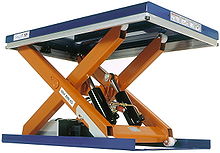Lift table
Lifting tables are aids for lifting and lowering loads. They are used as lifting floors , lifting platforms , lifting platforms and in various areas of intralogistics . They are often designed as a scissor lift table .
Lift tables are operated as system lift tables, assembly lift tables, lift tables for transporting goods or loading lift tables and are subject to DIN EN 1570-1 of May 2012, applicable to lift tables that do not pass through fixed stops, in addition to the Machinery Directive 2006/42 / EC. If more than 2 stops are approached, lifting tables are subject to parts of the EN 81 regulations for elevators, or the following standard EN 1570-2 or EN 1570-3.
According to the information available to the author of August 24, 2009 from the specialist committee for conveying and storage technology of the German Social Accident Insurance, the quality requirements mentioned in VBG 14 have been suspended with the coming into force of the Machinery Directive 98/37 / EC, or the entire VBG 14 has become Repealed in late 2003.
construction
A lifting table has a platform or an upper frame on its upper side as a base or work surface. Below it stands on a base frame or rack . Self-supporting base frames are required for lifting tables that are set up on non-flat surfaces.
In order to conceal and shield the mechanics, a lifting table can be equipped with a chain curtain, bellows or PVC curtains.
Parapets on the work surface are required if people step onto the platform and the height of fall is more than 50 cm. Portal railings are suitable as fall protection for loading lift tables that are placed in front of a loading ramp .
Scissor lift tables
In this scissor base frame the bearings of the run scissors , consisting of two legs of equal length, which is a rotation joint to move the focal point of the legs. On the fixed bearing side , the scissors are connected to the base frame and the platform. The scissor bearings equipped with sliding rollers are located on the floating bearing side. Lift tables are usually driven by hydraulic cylinders , threaded spindles , belt drives or push chains .
Scissor lift tables are designed as single scissor lift tables, tandem lift tables or double scissors. Single scissor lift tables are lift tables in which one pair of scissors is used on each long side. Tandem lift tables are lift tables in which two scissors are placed next to each other on each longitudinal side, so that the lift table has a greater length. Lifting tables with two scissors on top of each other are referred to as double scissors. This results in a greater final height.
Lifting tables with double scissors - i.e. 2 scissors on top of each other - can be constructed relatively free of fluctuations by using bearings that are free of play. The swaying of lifting tables with three or more scissors lying one above the other can often only be avoided with separate side guides.
Dimensions
The height of the table top and the substructure result in the so-called construction height when retracted. As effective stroke the difference between height and final throw is called.
Load sharing
Lift tables are divided into lift tables for even load distribution and lift tables for uneven load distribution.
Even load distribution means that 100% of the load is distributed over the entire surface of the table, or 33% over half of the surface lengthways, or 50% over half the surface widthwise. Rolling load with load distribution of 50/50 per axis may act at 60% of the nominal load capacity over the long side of the table, or 50% over the narrow side of the table. When raising and lowering the lifting table, the center of gravity of the load should be approximately in the middle of the longitudinal axis of the table.
Uneven load distribution means that the lifting table has to carry the static load on 70% of the surface lengthways or across. Rolling load over the long side must be 90% of the total load capacity with a load distribution of 50/50 per axle. Rolling load over the narrow side must correspond to 40% of the load capacity of the table with a load distribution of 50/50 per axis. It is assumed that the load moves in the center of the table.
safety
The safety requirements for lifting tables are specified in EN 1570-1 from May 2012, publisher: CEN (European Standards Committee) . These include:
- Dead man's switch: A lift table may only rise or fall as long as the corresponding switch is held down.
- Emergency stop : Each lifting table must have an emergency stop switch on its control unit.
- Safety contact strip: Lifting tables must have a contact strip on the underside of the table top, which triggers when touched and immediately stops the movement of the lifting table, if the defined foot free spaces cannot be maintained and crush and shear points arise.
- Tear plate : If the lifting table is to be entered by people, the platform surface must be designed to be non-slip. A passenger ride is generally only permitted for the operator who is accompanying the load.
- Worker safety : If you work on the workpiece on the scissor lift table while the lift table is moving up or down, EN 1570 applies. After that, the lifting table must be equipped with a suitable safety device to avoid unintentional lowering. A lock , a second independent drive or hydraulic catching cylinder can be considered.
application areas
Lifting tables are used in the commercial sector as height compensation in the context of ergonomic workplace design or when transferring workpieces from one level to the other. Another area of application is loading. Here lifting tables can be used as loading lifting tables to enable smooth loading and unloading.

